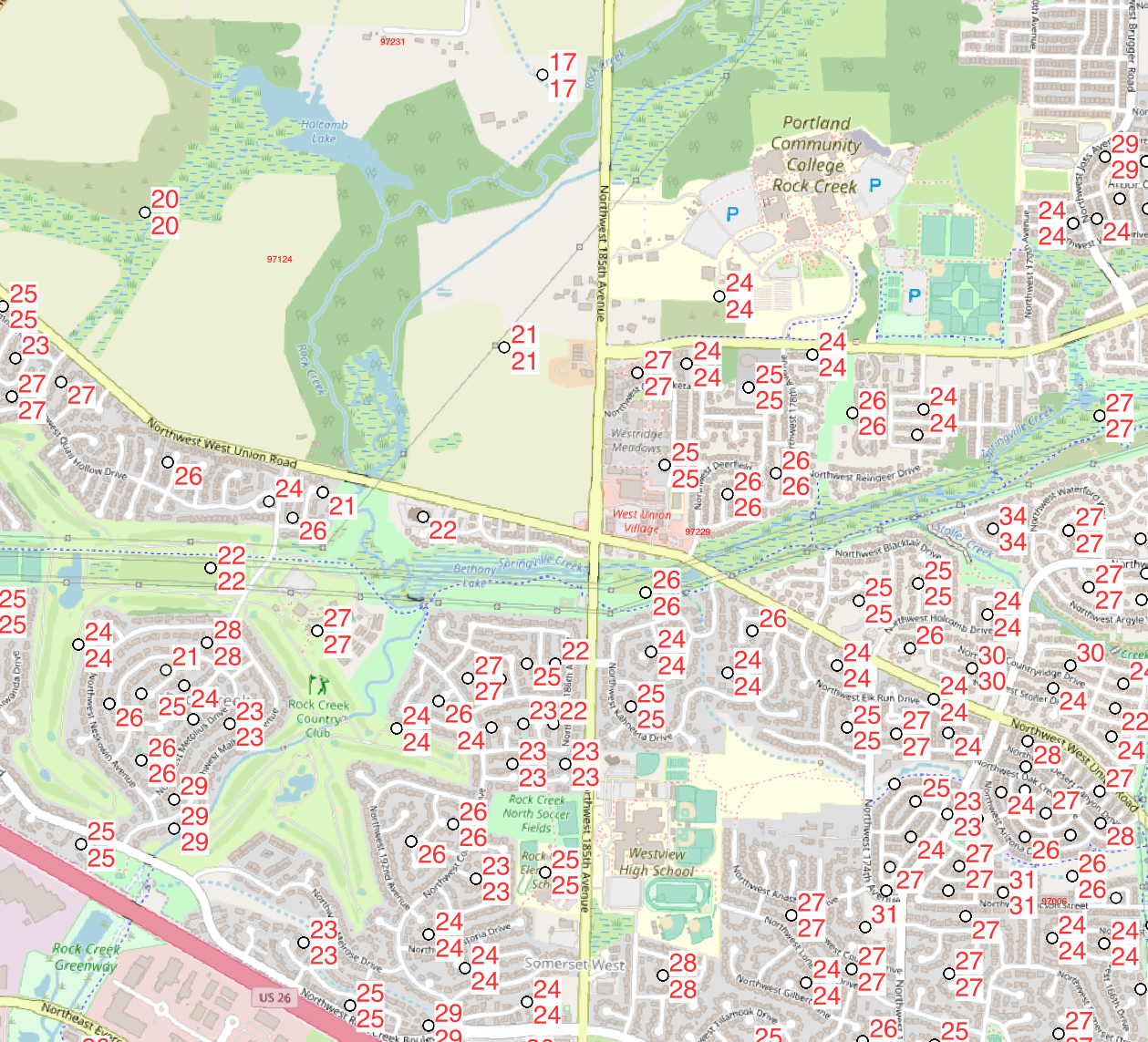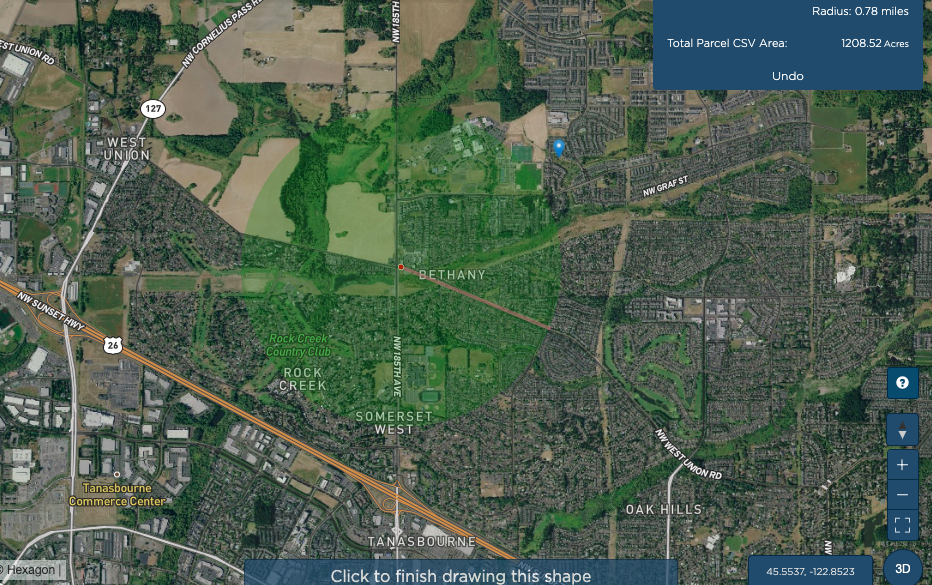Neighbors Against Bethany Lake Gas Station
Table of Contents
How much fuel does the immediate “urban neighborhood need”?
Author: Brandon Philips brandon@nabgas.com
These calculations use data from the Oregon DMV, US Department of Transportation, and other authoritative sources (see assumptions section at the end of the document) to try and estimate how much fuel is actually needed by the immediate urban area around 185th and West Union. It is also important to keep in mind that these numbers likely represent a near maximum need as the community continues its shift to using electric vehicles in the coming decades.
How many cars are there?
Using the MapRight GIS tool I drew a 0.78 mile radius map around the proposed site and generated a report of parcels within that radius. The parcel report had 2,147 single family residences, 193 condos, and 13 apartment complexes. I assumed each apartment could house 30 households which I think is generous given the size of apartment facilities in this area.
Adding it up the total households given this report is 2,730.
2147 + 193 + (13 * 30)
And if every household has an average of 2 cars that is 5,460 cars.
However, about 3% of registered cars in these zip codes are electric (see economic perspective). This gives 5,296 cars.
How much gas do they need?
5,296 cars with an average fuel economy of 24MPG driving an average mileage of 12,218 miles a year gives 224,675 gallons of fuel per month.
((12218.0 / 24.0) * 5296) / 12
Conclusion
The applicant’s application documents imply they are expecting to sell 248,327 gallons a month at this site by comparing this site to another station they own in their trip estimate application document:
The applicant operates numerous Chevron gas stations with convenience stores throughout the region. Annual (2019) sales volume information was provided by the applicant for the applicant’s highest- performing Chevron “gas station with convenience store” facility in the area, along with the following additional information:
The data provided is for the Chevron “gas station with convenience store” facility located at the Woodburn Interchange on I-5 (hereafter referred to as the “Woodburn Chevron”).
The number of fueling stations provided at this gas station (12) is identical to the number in the proposed development
In 2019 this facility ranked #2 in gasoline sales volume for all of the Chevron facilities located in the Pacific Northwest.
In 2019 this facility sold 3,590,287 gallons of fuel.
The applicant seems to be aimiing to sell more gasoline than the 224,675 gallons needed to serve 100% of the fuel needs of all cars in the immediate urban area. And even then it seems unlikely the station should fulfill 100% of fuel demand as many will choose to fill near industrial centers close to their place of business at least part of the time.
(248327 - 224675) / 248327
The applicant is claiming a hardship and asking the county for a variance for a larger gas station to sell 10% more fuel than is needed to service 100% of the fuel needs of every vehicle in the “immediate urban area”. I think it is fair to say three things about this:
-
Approving a variance for a larger service station does not serve the purpose of the Neighborhood Commercial zoning.
-
It is very unlikely that the gas station would ever service 100% of the fuel demand of all vehicles in the immediate urban area and even if the station did service 100% of the immediate urban area this application is oversized by 10%.
-
Electric car sales will continue to accelerate this decade so fuel sales will continue to shrink going forward.
Does the Neighborhood Code need an update?
In a April 16, 2021 report the Washington County Land Use Staff write:
As a practical matter, if staff was directed to amend the CDC to restrict the number of fuel pumps allowed for service stations in the NC District, staff does not know the basis upon which a maximum pump quantity would be set. There are likely market forces at play and specialized knowledge would be required to determine how many pumps may be appropriate to serve a smaller market, and whether that number would allow a service station to be profitable.
I disagree with this assessment that setting a maximum pump quantity is not practical for two reasons:
-
As the above calculations show there are data sets, available publicly and freely, that make estimating the service area of a fuel station possible.
-
The Neighborhood Code limits square footage of grocery markets, veterinary clinics, banks, marijuana facilities, and a long list of other types of businesses. Why are fuel stations exempt from codes on maximum size?
Assumptions
To make these calculations I have made a few assumptions:
- Average cars per household: 2 (source Data USA)
- Average mileage per year for Oregonians 12,218 (divide total miles traveled by state by registered drivers: Department of Transportation Registered Drivers and Department of Transportation Annual Vehicle Miles)
- Average fuel economy 24MPG (source energy.gov). This may be low based on Oregon DMV GIS data but we will stick with 24MPG for now.

- The applicant estimated gasoline to be sold on site is 248,327 gallons a month (source FAQ)
- The immediate urban neighborhood that this property should service as a requirement of this Neighborhood Commercial services is a 0.78 mile radius around 185th and West Union. This assumption is based on proximity to the other Neighborhood Centers like “Bethany Village” and the Arco station 1.6 miles down West Union.
